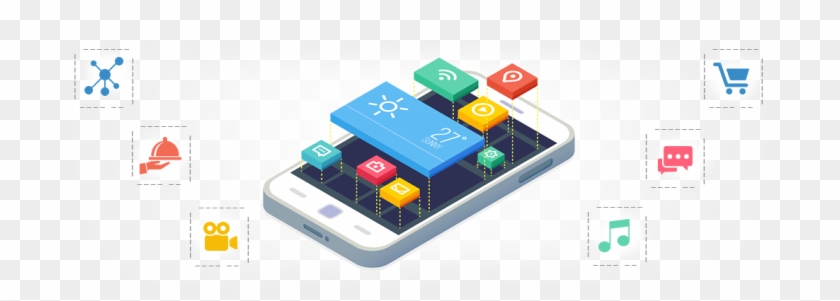
Unleashing the Power of Code: Exploring the World of Software Design and Development
In today’s digital age, mobile apps have become an integral part of our lives, revolutionizing the way we communicate, shop, and entertain ourselves. Behind the seamless user experiences and innovative functionalities lies the realm of software design and development, where skilled individuals unleash the power of code to create these captivating applications. Software design and development is a multidisciplinary field that encompasses various stages, tools, and methodologies to bring ideas to life. In this article, we will delve into the world of software design and development, exploring the diverse types of mobile applications and the fascinating process behind their creation. Whether you’re a curious technology enthusiast or aspiring developer, this journey will provide valuable insights into the exciting world of mobile app development. So, let’s dive in and unleash the power of code together.
Understanding Mobile App Development
Mobile app development is a rapidly growing field that plays a crucial role in the software design and development industry. With the widespread use of smartphones and tablets, mobile apps have become an integral part of our daily lives. From gaming and entertainment to productivity and navigation, mobile applications cater to various needs and interests.
Software design and development for mobile apps involve creating applications specifically designed for mobile devices. Unlike traditional software development, mobile app development requires a deep understanding of the unique characteristics and constraints of mobile platforms. Developers utilize specialized programming languages and frameworks to build mobile apps that are compatible with different operating systems such as Android and iOS.
There are various types of mobile applications that can be developed, each serving a different purpose. Native apps are built for a specific operating system and are optimized to fully leverage the features and capabilities of that platform. On the other hand, web apps are accessed through a web browser and do not require installation. Hybrid apps combine elements of both native and web apps, allowing developers to create cross-platform applications with a single codebase.
Mobile applications have revolutionized the way we interact with technology, offering convenience, accessibility, and a wide range of functionalities at our fingertips. As the demand for mobile app development continues to grow, it is crucial for developers to stay up-to-date with the latest trends and advancements in this ever-evolving field.
Exploring Software Design and Development
In today’s technology-driven world, software design and development play a pivotal role in shaping our digital landscape. From the creation of mobile apps to the implementation of complex systems, the art of bringing code to life has revolutionized the way we interact with technology. In this section, we will delve deeper into the fascinating world of software design and development, exploring its various aspects and shedding light on its significance in our modern society.
At the forefront of software design and development lies the creation of mobile applications. With the widespread use of smartphones and tablets, the demand for innovative and user-friendly apps has skyrocketed. Mobile app development involves the process of designing, building, and launching software applications specifically tailored for mobile devices. From gaming and entertainment to productivity and e-commerce, there are various types of mobile applications that cater to different needs and preferences.
In the realm of software design and development, every successful mobile app begins with a solid foundation. This includes defining the app’s purpose, identifying the target audience, and outlining the key features and functionalities it will offer. The next step involves creating a visually appealing and intuitive user interface (UI) that ensures a seamless and engaging user experience. Furthermore, developers need to consider the compatibility of the app with various mobile platforms and devices to reach a wider audience.
Mobile applications have become an integral part of our lives, providing convenience, entertainment, and efficiency at our fingertips. Whether we are using social media apps to connect with friends, fitness apps to track our progress, or banking apps to manage our finances, these mobile applications have revolutionized the way we interact with technology. The continuous advancements in software design and development open up endless possibilities, allowing us to explore new horizons and unleash the full potential of code.
By delving into the world of software design and development, it becomes evident how this discipline has transformed the way we live and interact with technology. Mobile applications, in particular, have become an indispensable part of our daily routines, catering to our diverse needs and providing us with enhanced functionality and convenience. As technology continues to evolve, software design and development will remain a vital force in driving innovation and shaping our digital future.
Types of Mobile Applications
Cloud-based mobile app development
There are various types of mobile applications that cater to different user needs and preferences. From productivity and communication to entertainment and gaming, mobile apps have become an integral part of our daily lives. In this section, we will explore some common categories of mobile applications.
Productivity Apps: Productivity apps are designed to help users enhance their efficiency and manage their tasks effectively. These apps provide features like task management, note-taking, calendar synchronization, and document editing. Popular productivity apps include Evernote, Microsoft Office Suite, Trello, and Google Drive.
Social Networking Apps: With the rise of social media, social networking apps have gained immense popularity. These apps enable users to connect, share, and communicate with friends, family, and colleagues. Examples of social networking apps include Facebook, Instagram, Twitter, and LinkedIn.
Entertainment Apps: Entertainment apps offer users a wide range of digital content for leisure and enjoyment. These apps provide access to music, videos, movies, books, and games. Streaming services like Spotify and Netflix, gaming platforms like Angry Birds and Pokemon Go, and e-book readers like Kindle are all examples of entertainment apps.
Utility Apps: Utility apps provide specific functionalities and tools to assist users in everyday tasks. These apps include weather apps, calculators, language translators, QR code scanners, and flashlight apps. Some popular utility apps are AccuWeather, Google Translate, CamScanner, and Flashlight.
E-commerce Apps: E-commerce apps have transformed the way we shop by providing a convenient and seamless online shopping experience. These apps allow users to browse, purchase, and track orders from the comfort of their mobile devices. Well-known e-commerce apps include Amazon, eBay, Flipkart, and AliExpress.
Health and Fitness Apps: Health and fitness apps help users maintain a healthy lifestyle by providing features like activity tracking, workout plans, calorie counting, and meditation guidance. Examples of health and fitness apps include Fitbit, MyFitnessPal, Calm, and Nike Training Club.
By understanding the different types of mobile applications, developers can create customized experiences that cater to the specific needs and preferences of users in today’s digital world.


